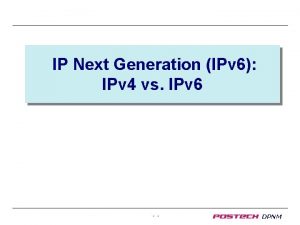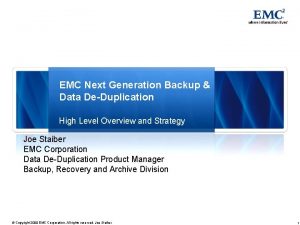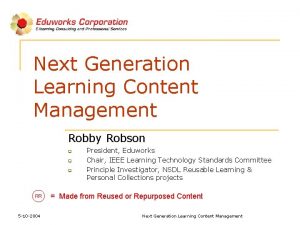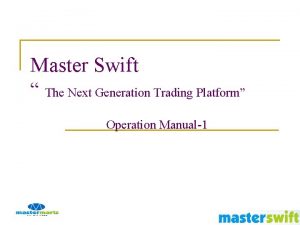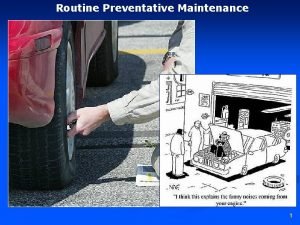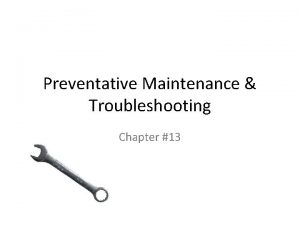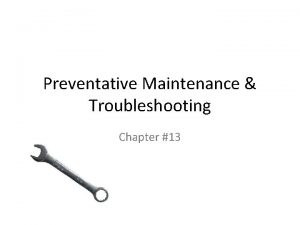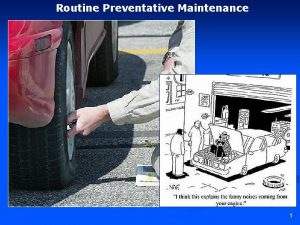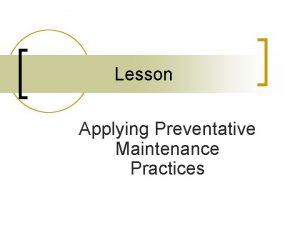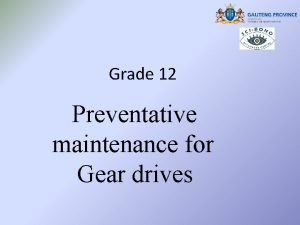Lesson 4 APPLYING PREVENTATIVE MAINTENANCE PRACTICES Next Generation

























- Slides: 25

Lesson 4 APPLYING PREVENTATIVE MAINTENANCE PRACTICES

Next Generation Science / Common Core Standards Addressed! CCSS. ELA Literacy. RST. 9‐ 10. 1 Cite specific textual evidence to support analysis of science and technical texts, attending to the precise details of explanations or descriptions. CCSS. ELA Literacy. RST. 9‐ 10. 3 Follow precisely a complex multistep procedure when carrying out experiments, taking measurements, or performing technical tasks, attending to special cases or exceptions defined in the text. CCSS. ELA Literacy. RST. 11‐ 12. 2 Determine the central ideas or conclusions of a text; summarize complex concepts, processes, or information presented in a text by paraphrasing them in simpler but still accurate terms. CCSS. ELA Literacy. RST. 11‐ 12. 3 Follow precisely a complex multistep procedure when carrying out experiments, taking measurements, or performing technical tasks; analyze the specific results based on explanations in the text.

Agriculture, Food and Natural Resource Standards Addressed! PST. 02. 01. Perform preventative maintenance and scheduled service to maintain equipment, machinery and power units used in AFNR settings. PST. 02. 01. b. Develop a preventative maintenance schedule for equipment, machinery and power units used in AFNR power, structural and technical systems.

Bell Work / Student Learning Objectives Explain the importance of preventative maintenance on engines and equipment Explain the safety practices to follow when servicing equipment Identify common maintenance practices associated with major engine systems

Terms Compression gage Flooding Preventative maintenance

Interest Approach List the reasons why it is important to follow the preventative maintenance schedule.

Preventative maintenance Performing of practices to keep equipment in good working condition. Properly maintaining agricultural equipment requires skill, practice, and quality management.

Preventative maintenance practices Changing fluids Cleaning components Replacing filters

Safety practices Read and follow all instructions in the operator’s manual. Know all the safety emblems and warning signs used for agricultural equipment. Use protective eyewear, clothing, and footwear.

Safety practices (continued) Use jack stands, engine stands, and other supports. Observe caution around fuels and flammable materials. Operate internal combustion engines in well-ventilated areas. Place machines in park and lower implements before working on them.

Safety practices (continued) Work in well-lighted and properly ventilated areas. Regularly clean the floor and remove obstacles and fluids. Handle batteries safely. Keep fire extinguishers and smoke detectors in shop work areas.

Safety practices (continued) Use caution when working around high pressure. Use protective hearing devices when working in loud areas. Safely dispose of used fluids.

Nine safety colors Red – danger Orange Yellow Blue – warning – caution – information Green Black – safety & yellow diagonal lines – radioactivity, hazardous work areas.

Nine safety colors (continued) White – direction of traffic flows and segregate work areas White & black stripes – traffic markings Gray shop – floors or work areas in the

Nine safety colors

Ignition system checks Inspect the spark plug wire Check the spark output using a spark tester Check the flywheel

Parts of a spark plug

Fuel system checks Insure that there is gas in the gas tank. Check the spark plug for gasoline. Check the flow of gas from the fuel tank to the fuel injector or carburetor on older equipment. Flooding – an excessive amount of gasoline in the carburetor in older equipment.

Compression system checks Compression gage – determines compression pressure of the cylinder.

Liquid cooling system checks Check the hoses and belts for leaks and cracks. Maintain the proper coolant level. Keep the system clean. Use recommended coolant. Pressurize the system and check for leaks. Check the specific gravity of the coolant. Check the condition of the fan.

Air cooling system checks Remove dirt that can clog air passages. Make sure the pre-cleaner is in place. Check the fan. Makes sure all shrouds are in place.

Lubrication system checks Check the engine oil level. Change the oil and filters.

Air intake system checks Connect a vacuum gauge to the intake manifold. Allow the engine to run for a few minutes. Record the age reading with the engine operating. Compare the readings to the manufacturer’s specifications. Inspect the intake system for possible restrictions and leaks.

Review/Summary Why is it important to practice preventative maintenance on engines and equipment? What are the safety rules to follow when servicing agricultural equipment? What are some common maintenance practices carried out on engine systems?

The End!
 Milling machine maintenance
Milling machine maintenance X.next = x.next.next
X.next = x.next.next Politeness theory in communication
Politeness theory in communication Education is a matter of the heart don bosco
Education is a matter of the heart don bosco First generation antipsychotics
First generation antipsychotics Oh lord you are good and your mercy endureth forever
Oh lord you are good and your mercy endureth forever Palo alto traps gartner
Palo alto traps gartner Next generation wireless communication market
Next generation wireless communication market Ncsbn clinical judgment measurement model
Ncsbn clinical judgment measurement model Intelligence driven defense
Intelligence driven defense Next-generation smart contracts
Next-generation smart contracts Vaccine therapy
Vaccine therapy Vendor selection matrix
Vendor selection matrix Next generation lms
Next generation lms Sinkhole palo alto
Sinkhole palo alto What is next generation text service
What is next generation text service Next gen nclex
Next gen nclex Electrical energy
Electrical energy Next gen emr
Next gen emr Ip next generation
Ip next generation Next generation backup
Next generation backup Educating the next generation of leaders
Educating the next generation of leaders Ngn
Ngn Robson management corporation
Robson management corporation Next generation math standards grade 2
Next generation math standards grade 2 Trojan uv swift sc manual
Trojan uv swift sc manual



















